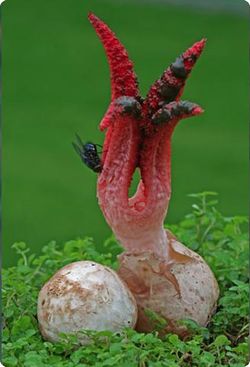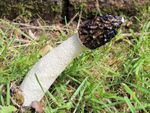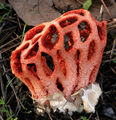Stinkhorn
| Stinkhorn |
|---|

|
| Scientific Classification |
|
| Genera |
|
Stinkhorns are any of the species of fungi belonging to the taxonomic family Phallaceae. They are best known for their stinky odor and odd shape from which they get their name. Stinkhorns are found in woodland areas where there is lots of decaying detritus. Stinkhorns are nasty little mushrooms (15 cm-8 inches, in size) whose spores are spread by flies. They are sometimes hard to get rid of because the spores are distributed over a great distance. They grow in the weirdest shapes you can imagine.
Body Design
Stinkhorns originated from the tropics to North America. Stinkhorns are 15 cm tall, and are known for being the Devils dipstick because you will often times smell their nasty odor before you see them. The smell comes from the slime on top of the fruiting body which attracts flies and other insects. [2] The Stinkhorns are mostly known for their awkward shapes. Some look like penises, horns, crab pinchers, and octopus’s tentacles. Stinkhorns also have different colors to match their weird shape such as beige, white, black, olive and red. One stinkhorn, Phallus impudicus, is a misnomer for a yellow morel by mushroom hunters that hunt for them during the summer. Morels don’t grow during the summer, but grow during spring.[3]
Life Cycle
The life cycle of a stinkhorn is very weird. Once it matures, it gives of a pungent odor that smells like rotten flesh that attracts flies. When the flies come, they land on the slime that contains spores. Spores stick to the fly like pollen sticks to bees. Then, the fly eats the slime that carries the spores in the digestive tract of the fly to be spread out in different directions so the Stinkhorn can reproduce again. When it produces again, it starts off as a white egg in soil or decomposing matter and the rest of the white egg is underground. When water hits the egg, it will eventually grow into a Stinkhorn.[4]
Ecology
These stinkhorns are located in woodland areas but are mostly found in carnivorous forests. They are found near dead decaying detritus and healthy trees. Stinkhorns grow in North America because the soil, sod, wood chips, trees, are being invaded by humans. Stinkhorns don’t really have enemies, but some humans like to eat Stinkhorns, only at the egg stage refer to the life cycle paragraph. Stinkhorns grow during the summer time through October because they aren't able to survive the cold. [5]
How to Control
Besides the disgusting odor the Stinkhorn has, they can be beneficial to your yard. They do not affect grass or plants, and will break down mulch and organic material.[6]
Stinkhorns do not live for a long time so I would recommend plucking the Stinkhorn root before it fully grows back. Keep in mind flies carry their spores to different areas. Also, try to keep your soil dry. Stinkhorns grow on decaying matter, so get rid of tree stumps, pine chips and other decaying matter. There are no safe products for Stinkhorn fungus, so don’t use chemicals.[7]
Video
The development of the Stinkhorn Phallaceae
Gallery
References
- ↑ Encyclopedia of Life. Phallus impudicus EOL. Web. Accessed: February 1, 2018.
- ↑ Michelle, Keller. Stinkhorns Wisconsin Horticulture. Web. Revised: June 15, 2016.
- ↑ Kuo, Michael. Stinkhorns: The Phallaceae and Clathraceae Mushroomexpert.com. Web. Published: April 2011.
- ↑ Kuo, Michael. Stinkhorns: The Phallaceae and Clathraceae Mushroomexpert.com. Web. Published: April 2011.
- ↑ University of Florida. Stinkhorns solutionsforyourlife.ufl.edu. Web. Last Modified: October 20th, 2017.
- ↑ University of Florida. Stinkhorns solutionsforyourlife.ufl.edu. Web. Last Modified October: 20th, 2017.
- ↑ Carroll, Jackie. What Are Stinkhorns: Tips For Removing Stinkhorn Fungi gardeningknowhow.com . Web. Last Modified January: 12th, 2018.






